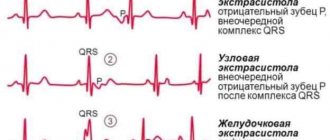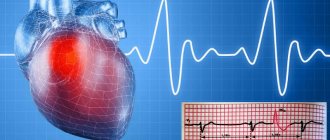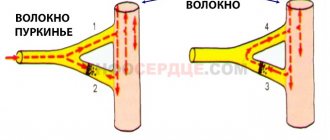Do they hire you for service if you have arrhythmia?
Assigning a category of unsuitability for the diagnosis of arrhythmia requires an accurate diagnosis and determination of the type of disease, since pathology has a certain classification.
During the examination of the conscript, attention is paid to the following aspects:
- Data indicated in the medical record to prevent the doctor from missing negative symptoms;
- Carrying out an electrocardiogram;
- Carrying out an ECG using special simulators at rest and physical activity;
- An accurate diagnosis is established after receiving all the research results and consulting with other specialists.
If the disease worsens, the conscript may be given a temporary deferment (from 6 to 12 months). If, after time, the negative symptoms go away, then it is possible to assign a different fitness category.
How to prove a diagnosis to the military registration and enlistment office?
The military commission makes a decision regarding the suitability of the conscript, paying attention to his ability to endure maximum physical exertion. Therefore, young men with a chronic form of cardiac arrhythmia and diagnosed non-cardiac diseases are assigned categories “G”, “B” or “D”, according to Article 42 of the List of Diseases.
The final verdict regarding a young man with a sinus variant of arrhythmia is made after determining the type of arrhythmic condition. After assessing the severity of the condition, taking into account the frequency of arrhythmia, its degree and the presence of signs of heart failure, antiarrhythmic drugs are prescribed on an ongoing basis.
If a conscript is found to have a permanent form of pathological condition with a low or high heart rate, then he is assigned category “D”. To assess the functional capabilities of the myocardium, stress tests are used - treadmill testing and six-minute walking. In addition, it is mandatory to check the contractile function of the heart muscle using echocardiography.
In the presence of heart rhythm disorders, there is always a risk of serious complications with a natural transition to severe clinical forms:
- paroxysmal tachycardia;
- primary prolapse;
- cardiosclerotic lesion;
- extrasystoles of ventricular origin;
- Adams-Stokes-Morgagni syndrome;
- pacemaker weakness syndrome.
If a young man is found to have such conditions, then he has the opportunity to be freed from the army. In addition, it is necessary to treat the disease, and not wait for the development of myocarditis, thromboembolism, myocardial infarction or cardiosclerosis. After the completed treatment measures, you can requalify into category “B”. Then the conscript becomes fit for wartime.
The draft commission, after an in-depth examination, issues a conclusion on the basis of which it is given a deferment, completely released from service, or called up for service. The chairman of the commission is a cardiologist.
A comprehensive examination for such diseases includes the following items:
- electrocardiography in a calm and excited state;
- basic tests;
- stress tests and tests.
If necessary, 24-hour Holter monitoring is performed to assess cardiac activity over 24 hours. Based on the results obtained, the military commission makes a collegial decision, taking into account the opinions of several specialists.
It should be noted that during a detailed examination, all medical records from the patient’s medical record, which is located in the clinic at the place of residence, may be required. If the conscript does not have medical documentation confirming the fact of arrhythmia, then the military expert commission may not detect a heart rhythm disorder. And minor changes in the cardiogram can be explained by characteristic anxiety before conscription.
In addition, with mild cardiac arrhythmia and the absence of other pathologies, a conscript can be considered suitable for the army.
In which troops can you serve with grade 1 cardiac arrhythmia?
Identification of a diagnosis of arrhythmia implies the assignment of appropriate fitness categories (“B”, “C”), depending on the progressive symptoms of the disease, conscripts must serve in the following troops:
- Category "B" (fitness for service with some restrictions). A conscript can serve in guard duty, drive a car, do missile or gun crews, and repair equipment in the railway troops;
- Category "B" (limited suitability). In this case, the conscript is exempt from military service and is assigned to the reserve forces with a call to military training. In the event of hostilities, he may be called up in the 2nd order and has the right to undergo a second medical examination.
Is the disease a contraindication to service?
Abnormal heartbeat can often indicate the presence of serious pathologies. Arrhythmia is divided into the following types:
- tachycardia - rapid heartbeat;
- bradycardia – slow heartbeat;
- extrasystole - extraordinary heart contractions.
Independent sinus arrhythmia most often is not a reason for determining unfitness, but the conscript has the right to undergo an examination, with which a temporary category “G” is assigned - a deferment for a period of 6 to 12 months. The final category of eligibility will depend on the associated abnormalities, frequency and severity of attacks.
As a rule, even if dangerous arrhythmic conditions are detected, you will not be able to immediately obtain a military ID. The conscript will be able to receive it after two or three calls with the same complaints. One of the determining factors will be the presence of old records of the disease in outpatient records.
What is a contraindication
If the arrhythmia occurs as a result of a complication of another disease of the cardiovascular system, there is a high probability that military service is contraindicated with the underlying disease. If attacks of arrhythmia are accompanied by persistent severe pain in the chest or obvious deviations of the vegetative-vascular system, the medical commission of the military commissariat is obliged to issue the conscript with an examination certificate to determine the root cause of heart rhythm disturbances.
Diseases that can trigger the appearance of arrhythmic syndrome:
- cardiac ischemia;
- hypertonic disease;
- heart defects of various types;
- rheumatism;
- cardiosclerosis;
- VSD;
- asthma;
- acute heart failure;
- diabetes mellitus of the first and second types;
- diseases of the gastrointestinal tract;
- acute infections, etc.
Important! Most major diseases with concomitant arrhythmia and its complications (frequent attacks, acute pain, dysfunction of the heart, blockades) completely exclude the young man’s suitability for service.
If there are any complications of arrhythmia, it is necessary to report the symptoms to the medical commission. According to article No. 44 of the disease schedule, fitness categories “B” and “D” are assigned when:
- atrial fibrillation and paroxysmal arrhythmia with complications;
- polytopic extrasystole (with several ectopic foci).
What is not a contraindication
Those citizens who are at risk of developing functional complications are exempt from conscription, while the main types of arrhythmias are often not contraindications to service. If the diagnosed arrhythmia is not a consequence of an underlying disease of the cardiovascular system, the conscript will receive fitness category “B”.
Independent types of arrhythmias that are not grounds for disqualification :
- tachycardia, in which the pulse ranges from 90 to 140 beats per minute;
- bradycardia, the cause of which is not endocrine, cardiovascular or nervous system diseases;
- monomorphic extrasystole (with one epicentric focus).
Sinus arrhythmia and the army
The possibility of serving in the army with a diagnosis of sinus arrhythmia is determined by the type of progression of the disease. Concepts such as this pathology and the army can be quite compatible if the disorders do not have organic causes of origin.
An exception is the appearance of constant attacks of slow or increased heart rate in a pronounced form. This condition requires special control and observation, and is therefore a contraindication for military service.
Atrial fibrillation and ventricular arrhythmias
In addition to sinus, there are other types of disease that are clearly incompatible with the army, which are prescribed in Article 44 of the “Schedule of Diseases.” After studying the medical record and research results, the doctors who are part of the military medical commission decide whether to take the guy with the detected rhythm disorder into the army or leave him in civilian life.
Young people with serious diagnoses are not called up for military service:
- atrial fibrillation and arrhythmia;
- ventricular extrasystoles in a pronounced form.
Constantly occurring attacks, regular disturbances in cardiac activity, requiring drug treatment, after which relapses occur, will become the basis for enlisting in the reserve or declaring the guy unfit for the army.
The letter “B” affixed to a military ID will mean that in peacetime the young man should not be afraid of receiving summonses. The letter “D” exempts the young man from conscription for life.
The category that determines the future of a particular citizen is assigned according to the list of “Schedule of Diseases”.
Read more about what military fitness categories mean here.
Atrial fibrillation and the army
The concept of atrial fibrillation implies the presence of dangerous pathologies for which the conscript is entitled to be assigned category “D”:
- Paroxysmal tachycardia with atrial flutter and fibrillation;
- The appearance of Adams-Stokes-Morgagni attacks;
- Certain forms of ventricular extrasystole;
- Sick sinus syndrome.
The above diagnoses require serious treatment and surgical intervention. Therefore, the conscript is advised to have a temporary deferment with further monitoring of the disease over time.
To serve or not to serve
Let us consider how compatible the two concepts of “ ari” are. Today, several types of disease are diagnosed, including sinus, atrial, ventricular and paroxysmal. All of them are a consequence of disruption of the passage of impulses responsible for the contraction of the heart muscle.
Important! Cardiac dysfunction can have various causes, indicating the presence of other pathologies. Such cases are considered by members of the draft medical commission, taking into account the type of illness, its severity and the restrictions associated with the disease causing the deviation.
One way or another, diagnoses are associated with the disease, which are not accepted into the army with concomitant sinus arrhythmia of the heart . This:
- arthritis, lupus, arthrosis and other diseases from the rheumatoid group;
- chronic diseases with impaired myocardial function;
- mitral heart valve deformities;
- various types of heart defects;
- dysfunction of the cardiovascular system.
So, with arrhythmia, they are taken into the army , but only if its cause is not a disease from the list, according to which the conscript is assigned fitness category “D” - unfit. Other options are being considered in favor of conscription.
Sinus bradycardia and army
The phenomenon of bradycardia does not cause concern for human health, but it can be a complication of other serious diseases developing in the body. Most often, this pathology is mild sinus node syndrome.
List of other diseases that cause bradycardia:
- Oncological pathologies;
- Brain damage;
- Stomach or duodenal ulcer;
- Thyroid gland dysfunction.
The assignment of the category of unsuitability is carried out for such manifestations as atrioventricular block of the first degree, complete block of one branch of the His bundle.
What is arrhythmia and when is it dangerous?
According to the legislation in force in 2020, all males over 18 years of age are subject to conscription. But there are a number of certain conditions under which a young man cannot be called up for compulsory service. The main reasons for exclusion from conscription are health conditions.
Every person often has to deal with sinus arrhythmia. Arrhythmia is a disturbance in the contractions of the heart muscle, an uneven heartbeat. It is enough to get excited, carry a heavy bag, or quickly climb the stairs for an arrhythmia to occur.
How dangerous an arrhythmia is depends on the reasons that provoked it
Doctors from the commission at the military registration and enlistment office understand this perfectly: arrhythmia is detected in two out of three conscripts. But this does not mean that all of them will not be removed from compulsory service. First, the doctor will definitely send young men with arrhythmia for a comprehensive examination and only after drawing up a complete medical history will he make a conclusion about suitability for military service.
Arrhythmia is not a reason to panic, but it is also not such an innocent phenomenon to ignore. Especially if the question of whether or not to serve a young man is being decided. The so-called sinus node is responsible for the rhythm of contractions of the heart muscle.
If its functions are impaired, the heart begins to contract either faster than normal (tachycardia is diagnosed), or, conversely, rarely and unevenly (this condition is called bradycardia). Any type of arrhythmia is not an absolute contraindication to military service.
The decision is made taking into account a number of factors:
- how often does arrhythmia occur;
- under the influence of what factors;
- what is the root cause of arrhythmia;
- the presence of other pathologies in the young man.
At the same time, even arrhythmia caused by anxiety before passing a medical examination, and not by pathology, can become a precursor to a heart attack if predisposing factors coincide.
To receive a “white ticket” due to arrhythmia, you will first have to prove that it is, in fact, a sign of a disease that can threaten the health and life of the conscript
Does arrhythmia affect military service?
Many people are interested in the question of how much influence arrhythmia has on military service. Minor changes in the functioning of the cardiovascular system do not give the corresponding category of unsuitability.
At the same time, the development of serious pathologies, discussed in more detail above in the article, requires mandatory release from the army, since diseases worsen with increased physical activity or emotional stress, which can lead to irreversible processes in the body.
Are they recruited into the army with ventricular extrasystole?
With ventricular extrasystole (one of the types of cardiac arrhythmia), untimely contractions of the ventricles of the heart occur - in other words, such contractions are called extrasystoles. This phenomenon does not always indicate certain diseases; extrasystole in some cases can also occur in absolutely healthy people.
Experts from the draft commission do not consider ventricular extrasystole as a disease. For this reason, all young men with a similar diagnostic conclusion are drafted into the army. Doctors claim that vegetative-vascular dystonia and neurosis are an unqualified diagnosis of other diseases with such symptoms, for example: diseases of the nervous system and psyche, possible heart disease, hypertension, improper functioning of the vascular system.
For this reason, doctors from the military commissariat sign up and take the young man to serve, believing that a healthy diet in the army, regular stay in the fresh air, daily routine and physical activity will cure those suffering from ventricular extrasystole.
What decision will the draft board make if arrhythmia is diagnosed?
To make a decision on the category of suitability for the army when diagnosed with arrhythmia, the commission must rely on the presented reasons for changes in heart rhythm. The most common symptom is sinus arrhythmia.
With such a diagnosis, military service is not contraindicated (with the exception of the need for surgical intervention or a potential health hazard). In some cases, physical training has a beneficial effect on the body in the presence of arrhythmia.
How does the military medical commission make a decision on the fitness of a conscript?
Cardiologists distinguish 2 types of extrasystole: functional and organic. Often young people have type 1 disorder. In this case, arrhythmia is caused by stress, emotional and physical stress, and drinking alcohol, coffee or energy drinks. The pathology of heart contractions, as a rule, does not pose a danger to young men and in most situations does not require therapy: as soon as the condition that provoked the syndrome is eliminated, the heart rhythm will return to normal. Organic type disorders appear with significant cardiovascular diseases: myocardial infarction, ischemic disease, cardiac muscle dystrophy. As a rule, this type of disease is typical for the population over 40-60 years of age.
The second criterion that determines the relationship between extrasystoles and service is whether the extrasystoles are amenable to therapy. They will accept service if the disorder can be easily eliminated with the help of medications or goes away on its own. In order to be released from the army, one must also prove that the violation is of a persistent nature.
Another factor on which the future of a conscript citizen depends is the classification of the violation. The decision on suitability is made after comparing the specialist with the Lown-Wolf characteristics, which were given above in the article.
What types of arrhythmias are not allowed into the army?
Arrhythmia may indicate a serious illness in the body. If the following pathologies are identified, the commission assigns category “D” (complete exemption from the army):
- Mitral valve prolapse;
- Cardiac ischemia;
- Heart failure;
- Neurosis, heart disease;
- Severe obesity.
The presence of such diseases requires a full examination and receiving prescribed treatment. If necessary, a repeated examination is carried out to monitor the pathology over time.
Arrhythmia complications incompatible with military service
You should undergo all examinations to identify the presence or absence of concomitant diagnoses and possible complications.
Often complaining of periodic attacks in which a slow or, on the contrary, excessively rapid heartbeat is noted, young people are not aware of the presence of other serious diseases.
The fact is that arrhythmia may not be a separate pathology, but a symptom of other ailments that imply a non-vocational category:
- ischemia;
- neuroses;
- obesity;
- heart defects;
- mitral valve prolapse.
Read more about whether people with mitral valve prolapse are accepted into the army.
Having discovered diagnoses that pose a serious threat to the health, and in some cases the life of a young man, the doctors of the military registration and enlistment office will not ignore the dangerous pathology, releasing him from the army.
The main thing is to prepare documents in advance that can confirm the disease when going for a medical examination.
Having doubts about the diagnosis, doctors at the military registration and enlistment office issue a referral for additional examination of the conscript.
Reviews
Reviews about the presence of arrhythmia and military service have different opinions, since the assignment of the appropriate category of suitability depends on the diagnosis and the cause of the change in heart rhythm.
My cardiogram revealed a slight arrhythmia, but the doctor said that there was no need to worry about it. At the commission at the military registration and enlistment office, I was assigned category "B". Now I’m waiting for the summons to arrive for compulsory military service.
Igor, Stavropol
And when they did a cardiogram for me, they diagnosed me with mitral valve prolapse and immediately sent me to the hospital to confirm the disease and prescribe treatment. The military registration and enlistment office issued a temporary deferment, but then complete release is necessary.
Alexander, Rostov-on-Don
Symptoms of the disease
To understand with severe sinus arrhythmia are recruited into the army , let’s find out the nature of the disease, its symptoms and the factors that provoke its development.
Important! A disease that affects the rhythm of heart contractions is a fairly well-studied phenomenon, which, although seemingly harmless, can lead to depletion of the heart muscle, disruption of the functioning of its valves, and an increase in the volume of its cavities.
Surely each of us has felt its signs in the form of:
- erratic heartbeat with rhythm disturbances, pauses and accelerations;
- increased frequency of contraction of the heart muscle;
- chest pain;
- shortness of breath;
- dizziness;
- fainting and semi-fainting states.
Even if these symptoms occur irregularly and quickly disappear without leaving any discomfort, you should think about why they suddenly appeared.
Heart block - will they be drafted into the army?
Today we will look at the important question of how to pass a medical examination and whether you will be drafted into the army with a heart block.
A distinction is made between impulse conduction disturbance and bundle branch block. In this case, the normal heart rhythm is always disrupted, and the disease can be complicated by fainting and convulsions, in rare cases leading to atrial fibrillation and flutter and the need to install a pacemaker. Examination of a conscript before the army with heart block takes place under Article 42 of the Schedule of Diseases. It is advisable to consult a doctor and collect the necessary documents before the start of conscription activities. Symptoms of heart block are similar to other manifestations of diseases, so the doctor should listen carefully to the conscript and analyze the data of diagnostic studies. Let us remind you that heart rhythm disturbances and blockades of proper impulse conduction can be caused by quite serious diseases, so before serving in the army you must consult a cardiologist to determine the exact causes of the malfunction of the heart. In medicine, several degrees of severity of the disease have been defined. A conscript can find out in advance whether someone with a heart block will be drafted into the army only after visiting a doctor and following the instructions for diagnosing the disease. They will not be accepted into the army with the following heart diseases; the examination is carried out under fitness category “D” (not fit for service) Article 42:
- complete atrioventricular heart block;
- 2nd degree atrioventricular heart block with Morgagni-Adams-Stokes syndrome (MAS) or with heart failure of 2-4 classes;
- permanent 2nd degree atrioventricular heart block without MAS syndrome;
- 2nd degree sinoatrial block;
- complete block of the bundle branches.
Thus, a conscript has the right to be released from the army with heart block with complete or partial non-conduction of impulses, as well as with absolute loss of the bundle branches from the normal functioning. The third degree characterizes the complete absence of impulse conduction; accordingly, the conscript also has the right to fitness category “D”. They are not accepted into the army if a conscript exhibits MAS syndrome, since an attack can result in undesirable consequences and even death. During a second-degree blockade, some impulses are also not carried out, which is the basis for exemption from service. To confirm, a consultation with a cardiologist and diagnostic results are required.
If the disease is not accompanied by significant changes, or with incomplete blockade of the right bundle branch, then these diseases are not a reason to stay at home. As for 1st degree heart block, which is characterized by mild symptoms with a significant slowdown in the speed of impulses. This means that it is best to identify the causes of the malfunction of the heart and establish the underlying disease, with which you can receive an anti-conscription fitness category. The existing symptoms of a conscript will help the doctor more accurately establish a diagnosis, and it may happen that he will not be drafted into the army under another article of the Schedule of Diseases.
Features of the examination
If a young person has congenital or acquired heart defects or other disorders of the cardiovascular system, this is usually indicated in his medical record. Members of the medical commission, of course, will not miss such records, because we are talking about a serious health problem; extreme physical and mental stress can aggravate the young man’s condition.
What is the difficulty? There is no cardiologist on the medical commission for conscripts. All young people are examined in turn by the following narrow and general specialists:
- therapist,
- dentist,
- ophthalmologist,
- otolaryngologist,
- surgeon,
- neurologist,
- psychiatrist.
But there is no cardiologist on the list. Only those young people who have previously been diagnosed with heart problems undergo it. The rest are usually allowed to serve without additional examination, if there are no visible grounds for it. A rapid heartbeat due to anxiety in this case is not a reason for referral to a cardiologist.
It so happens that our conscripts in most cases strive to avoid military service. And the military registration and enlistment office, accordingly, is interested in accepting as many young people as possible. Therefore, the medical commission does not examine young men very carefully, relying on the fact that serious pathologies would have been known for a long time, and if the deviations are minor, then there is no threat.
It is no secret that a medical examination at the military registration and enlistment office is more of a formality than a full and thorough examination.
However, it may happen that a young person has a pathology of the heart and blood vessels, but it is still hidden. And it can only be identified through a special, thorough examination. What to do in this case, how to prevent being sent to a service where the risk of exacerbation and attack increases significantly?
Usually, heart problems make themselves felt one way or another. Symptoms that should alarm young people of military age:
- frequent or periodic increase in heart rate for no apparent reason;
- uneven heartbeat, freezing of the pulse during physical exertion or excitement;
- dyspnea;
- pallor;
- pain behind the sternum, sometimes radiating to the arm and under the shoulder blade;
- state of anxiety, panic.
Even if only one of the listed symptoms is detected, if it bothers you only from time to time, it is better to play it safe and get yourself examined by a cardiologist. To begin with, the doctor will write a referral for clinical urine and blood tests and an ECG. After receiving the results, it will be possible to judge whether there are grounds for further diagnostic procedures.
Helpful advice: the results of a private examination with a cardiologist, symptoms and complaints must be recorded in the medical record. They take her with them to the military registration and enlistment office for a medical examination for conscripts and show her to the therapist. Based on the records, the young man is sent for examination by an independent cardiologist. The commission then decides to remove the young person from compulsory service or assign him status.
There is no cardiologist on the list of mandatory doctors for the medical board at the military registration and enlistment office; if necessary, you need to undergo it yourself.
What other categories can a conscript with arrhythmia receive?
If the initial examination shows that the condition of a conscript suffering from arrhythmia is not critical, he may be assigned the status “G” or “B”. Status “G” means that the young man cannot be recruited until he undergoes the necessary examination, and, if necessary, emergency treatment. After this, his suitability for military service will be reviewed again. That is, this status provides only a temporary deferment from service, but not complete removal.
Status "B" does not provide for deferment. The young man will be called up, but he will serve only in peacetime and will be in rear positions, in benign conditions. If a young man's well-being changes for the worse, his status may be reviewed by a medical commission.
Gastritis according to the schedule of diseases
It is on the basis of this document that the doctor determines whether the conscript is fit for military service or not. What is this document? This is a list that clearly defines the categories of suitability of young men for military service. Gastritis refers to Article 59, and indirectly to Article 61. Article 59 includes not only gastritis, but also other diseases of the gastrointestinal tract, and in particular the stomach. It is noteworthy that this article includes three points, but only two of them are directly related to gastritis - “B” and “C”.
- Article 59 "B". A conscript may be exempt from military service with the issuance of a military ID, although much depends on what decision the medical commission makes. There is a term “frequent exacerbations”, but there is no general interpretation of it. Therefore, in some regions, “frequent exacerbations” should occur at least twice a year, and in others – even more often. The absence of a medical history with complaints and symptoms over the past two years, outpatient rather than inpatient treatment and a diagnosis of “moderate gastritis” are all the reasons why one cannot even dream of a deferment or complete exemption from military service.
- Article 59 "B". The conscript is considered fit for military service, but with some restrictions. The young man will still become a soldier, but he will serve not in special forces or airborne troops, but in an ordinary (not elite) unit. The diagnosis of “acute gastritis” also fits this point, but only if exacerbations occur less than twice a year.
- Article 61. According to it, a young man may be granted a deferment if, during conscription activities, he has an attack of acute gastritis or a chronic disease worsens. Of course, this must be confirmed by an appropriate medical certificate.











